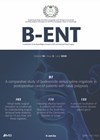
Journal Reviews
Relapse after bi-maxillary surgery in a class III malocclusion
This study analysed 90 patients who underwent a bi-maxillary osteotomy for a class III malocclusion. There were 30 in each of three groups of patients based upon the Frankfort mandibular plane angle (FMA). They were divided into: greater than 32°,...
Balloon eustachian tuboplasty and inferior turbinectomy
This Taiwanese prospective case-control study looked at concurrent inferior turbinectomy (via submucosal turbinectomy) and balloon eustachian tuboplasty on symptoms related to eustachian tube dysfunction. A total of 50 patients who underwent inferior turbinectomy with balloon eustachian tuboplasty were recruited prospectively...
Post-total laryngectomy constipation
This cross-sectional study investigated the prevalence of chronic constipation post total laryngectomy (TL) and after total pharyngolaryngectomy (TPL). For the study, the authors used a self-completed patient questionnaire to evaluate the prevalence and factors related to it. Patients using opioids,...
Correlation between middle ear and mastoid volumes with results of type 1 paediatric tympanoplasty
This is a retrospective study of 45 paediatric patients, aged between eight and 18 years, who underwent Type 1 cartilage graft tympanoplasty using conchal cartilage. Middle ear and mastoid volumes of these children were correlated with anatomical and functional outcomes...
Postoperative bleeding rates after inferior turbinate reduction using three different techniques
The most serious complication of inferior turbinate reduction surgery is postoperative bleeding, soon after the operation or later on. In this study comprising 751 patients, the authors have compared three common methods. Partial turbinectomy involved resection of the inferior turbinate,...
Prophylactic gastrostomy tubes in advance of chemoradiotherapy for advanced head and neck malignancies – are they worthwhile?
It is well recognised that radical chemoradiotherapy (CRT) for head and neck cancers can significantly affect swallowing, especially if radiotherapy is delivered to the hypopharynx and/or both sides of the neck. As such, prophylactic gastrostomy tubes are often advocated in...
Steroid use in acute acoustic trauma
Acute acoustic trauma (AAT) injuries include noise-induced damage to inner and middle ear presenting as hearing loss, tinnitus and vertigo. Classic presentation is sensorineural hearing loss with an intact tympanic membrane. The authors carried out a case-control study in military...
Inpatient or outpatient thyroidectomy?
This systematic review and meta-analysis discusses the safety of hemithyroidectomy in an outpatient vis-à-vis an inpatient setting. Thyroidectomy has traditionally been performed as an inpatient procedure. Currently, an increasing number of surgeons are performing thyroidectomy in outpatient settings. The main...
Hearing outcomes after mastoid obliteration tympanoplasty
In this study, the authors retrospectively compare hearing outcomes after mastoid obliteration to non-obliterative techniques in cholesteatoma surgery. They have performed canal wall up with mastoid obliteration (bony obliteration tympanoplasty or BOT) since 2013. The procedure has replaced canal wall...
Role of maxillary sinus irrigation as an adjuvant to current management of chronic rhinusitis without polyposis
Several decades have passed since irrigation of maxillary sinuses generally became a treatment of the past. A more recent concept of biofilms may have evoked new interest in this past procedure, fraught with its own issues. In this study, the...
Biologics for deafness
Cochlear implants and hearing aids are inherently limited in their ability to restore ‘natural’ hearing. Biological therapy to treat inner ear pathology still is evolving rapidly with several ongoing clinical trials, though none are available for clinical practice to date....
Eosinophilic or not eosinophilic: dupilumab seems to work
Chronic rhinosinusitis with nasal polyps (CRSwNP) is a type 2 inflammation with interleukin (IL)-4, IL-13, and IL-5. Tissue eosinophilia in nasal polyps dramatically increased over a 10-20-year period. Classification of the severity of eosinophil status is expected to lead to...














